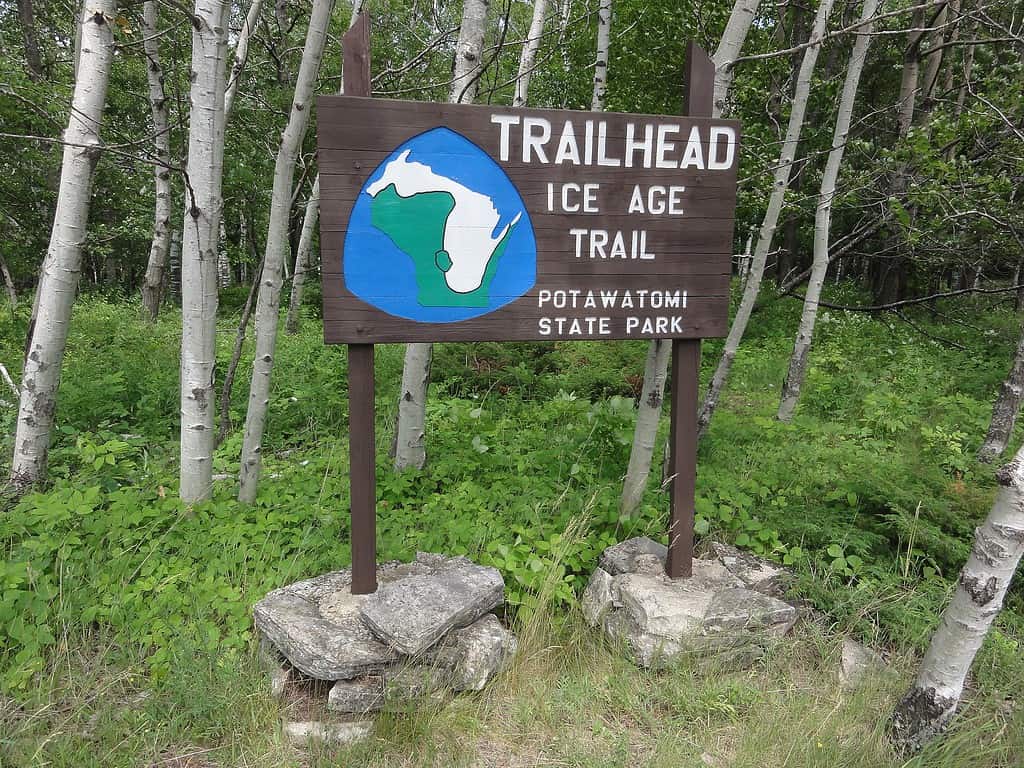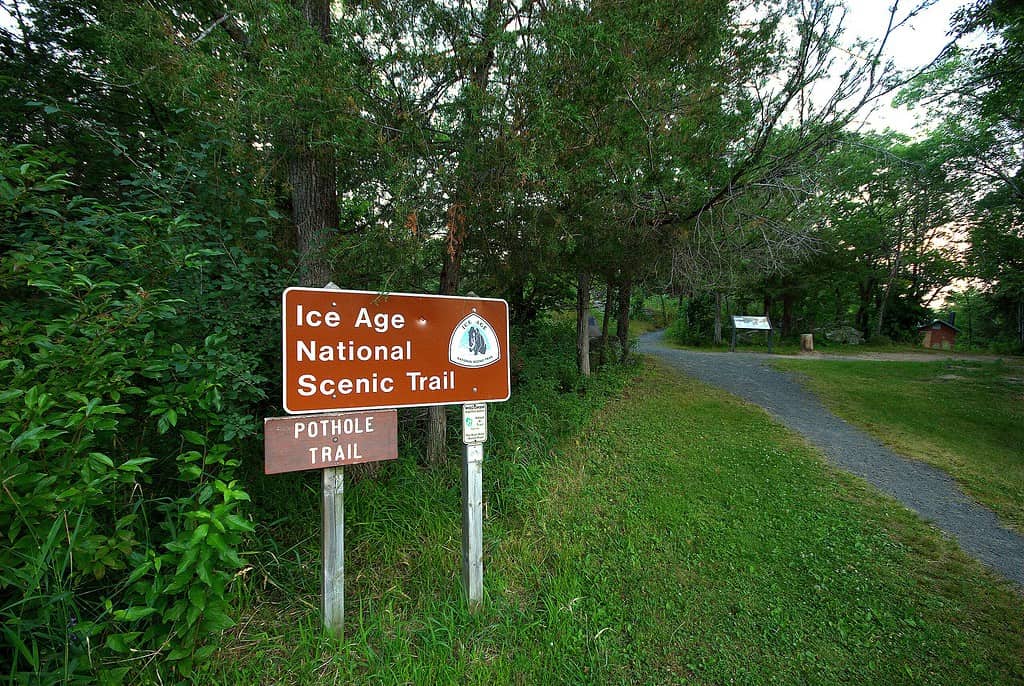Wooly mammoths and saber-toothed tigers roamed the land that makes up the popular Ice Age Trail. Now, hikers and nature lovers from around the country visit Wisconsin to complete the strenuous trek. Come along to find out where the Ice Age Trail starts and ends, and learn more about the lakes, river valleys, rolling hills, and animals you will encounter on your journey.
Where Does the Ice Age Trail Start and End?

The Ice Age Trail ends in Potawatomi State Park.
©Bart Everson from New Orleans, Louisiana, USA / CC BY 2.0 – License
The Ice Age Trail spans nearly 1,200 miles through Wisconsin. It stretches from the Minnesota border to the Green Bay arm of Lake Michigan. The Ice Age Trail starts in Interstate State Park on the St. Croix River in northwestern Wisconsin and ends in Potawatomi State Park outside Sturgeon Bay. The trail winds up and down the state, going as far south as Janesville in Rock County, before taking hikers north to the end of the route. The Ice Age Trail is one of only three National Scenic Trails within a single state, alongside the Arizona and Florida National Scenic Trails.
Route Details

The Ice Age Trail follows the borders of a glacier.
©Joshua Mayer from Madison, WI, USA / CC BY-SA 2.0 – License
The Ice Age National Scenic Trail is one of 42 designated Wisconsin trails, but it’s the only designated State Scenic Trail. It comprises varying biomes created by receding glaciers. The route follows the borders of the last continental glacier in North America, known as the Wisconsin glaciation.
Most of the trail is for off-road hiking through the abundant natural beauty of Wisconsin, but some segments permit cross-country skiing, snowshoeing, biking, and camping. Although the trail encompasses 1,200 miles, it’s not yet complete. The Ice Age Trail contains 100 segments of public and private property connected by rural roads and highways. Almost 700 miles of the trail are blazed and open for public use; however, nearly 500 miles are unmarked.
Moreover, the land is divided into city and state parks, and national forests, and private land. All of which passes through 30 counties and 19 municipalities. Every year, the Ice Age Trail Alliance purchases more land to protect the trail.
History of the Ice Age Trail

The Ice Age Trail exists because of Ray Zillmer and his supporters.
©MarynaG/Shutterstock.com
Ray Zillmer was an outdoorsman, mountaineer, and student of natural history. Originally an attorney in Milwaukee, his dream was to create a trail connecting the Kettle Moraine State Forest to the Wisconsin glaciers. His vision led him to create the Ice Age Park Foundation, now the Ice Age Trail Alliance, in 1958 and begin his campaign to establish a national park along the route. However, in 1960, the National Park Service deemed a trail hundreds of miles long through the glaciers too challenging to create. Zillmer passed away in 1961, but his supporters kept his dream alive.
Work on the long-distance hiking trail began in the 1970s, with the Glacial Hiking Trail in the Northern Kettle Moraine State Forest being the most prominent section. As a result, the Ice Age National Scientific Reserve was conceived. The National Park System was composed of nine stations around the state to preserve the incredible glacial formations and the surrounding landscapes.
The Ice Age National Scenic Trail was officially established on October 3, 1980, with President Carter signing it into law. Although Zillmer didn’t live to see his work pay off, the Ice Age Trail Alliance continues its conservation efforts, and over 2 million hikers enjoy the beauty of the Ice Age Trail every year.
Animals You Can Encounter Along the Ice Age Trail

The American badger is the Wisconsin state animal.
©Photography by Adri/ via Getty Images
The Ice Age Trail, from start to end, takes hikers through deep woods, around crystal-blue lakes, and various terrain that is home to many species. Some of the animals you will encounter along the way include:
- Bats
- American badgers
- Black bears
- Coyotes
- Frogs
- Herons
- River otters
- Squirrels
- Songbirds
- Snakes
- Toads
- Turtles
- Wolves
- White-tailed deer
Planning Your Hike

It takes two to three months to complete the Ice Age Trail from start to end.
©Martin Lemus/iStock via Getty Images
Over 100 hikers have completed the Ice Age Trail as thru-hikers or in one long adventure. Some have even finished the route section by section over a longer period of time. But no matter how they finished, they proudly hold the title of Thousand-Milers.
Are you ready to travel back to the Glacial Age and take on the Ice Age Trail? Here are some of the most important things to know before starting your hike:
- Familiarize yourself with the area ahead of time and always plan a destination.
- Know where to find the nearest roads.
- Pack maps, a compass, binoculars, a first aid kit, and a cellphone in your travel bags. Locate areas where cell phones work in case of an emergency.
- Tell someone you trust where you will be.
- Eat a nutritious meal before starting your hike, and take healthy snacks.
- Plan your route around the weather forecast.
- Wear clothes appropriate for the weather and bring layers with you.
- Follow Leave No Trace guidelines.
- Move away from suspicious people, and don’t tell strangers where you plan to camp.
The entire route takes about two to three months to complete. Plan and prepare according to the length of the segment you plan to hike.
The photo featured at the top of this post is © Bart Everson from New Orleans, Louisiana, USA / CC BY 2.0 – License / Original
Thank you for reading! Have some feedback for us? Contact the AZ Animals editorial team.






